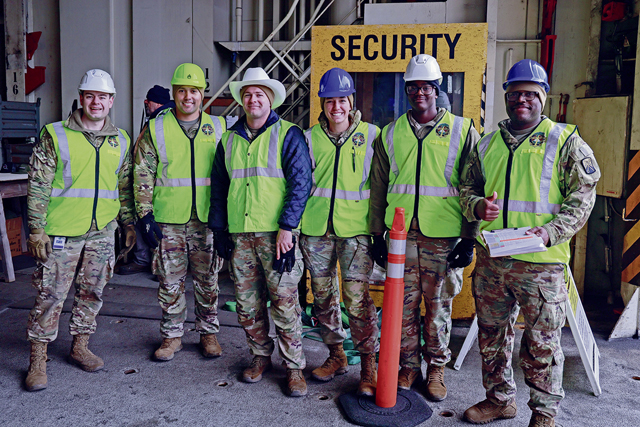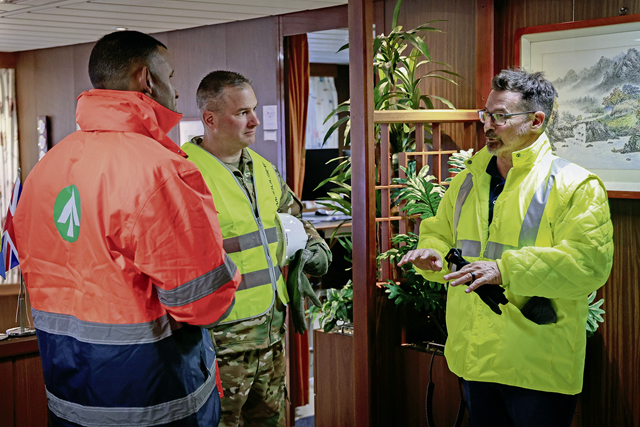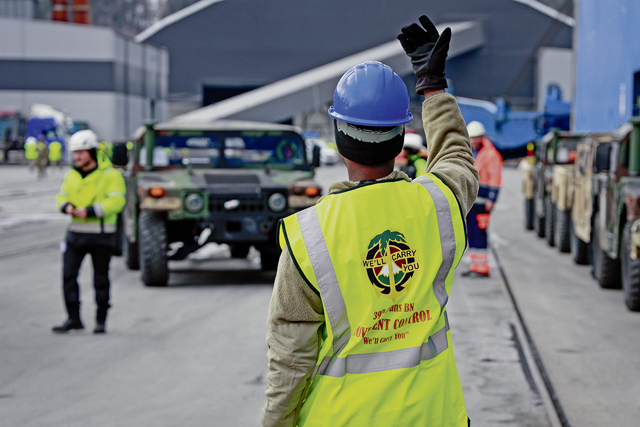
NARVIK, Norway — The 21st Theater Sustainment Command and 598th Transportation Brigade of the Army’s Surface Deployment Distribution Command, alongside their Norwegian Allies makes history today by setting the theater for the first time here during the Defender 2024 exercise April 24.
The act of setting the theater requires the 21st TSC to rapidly deploy equipment and Soldiers to the point of need during any potential crisis or conflict, enabling units to conduct their mission. Being able to strategically diversify host nation seaports and airports throughout Europe and testing their transportation networks’ capabilities gives the United States Army Europe and Africa commander options during any mission set to best employ forces.
Under the combined efforts of the U.S. Army and their Norwegian counterparts, over 500 pieces of equipment were delivered to Narvik, a vital port city in what is considered the “high north” within Europe. The operation aims to enhance strategic readiness and strengthen the alliance between the United States and one of NATO’s oldest and founding members, Norway.

This strategic and historic movement took a lot of joint planning between 16th Sustainment Brigade; 21st TSC; 3rd Brigade Combat Team, 10th Mountain Division; 598th Trans. Bde. and the Norwegian Armed Forces. The final multinational rehearsal and conditions check involving all parties the day prior was crucial to both the execution today and the future onward movement of every piece of equipment to Allies in Finland.
Maj. Gen. Ronald Ragin, commanding general, 21st TSC, emphasized the importance of working together in the high north during Defender 2024. Ragin’s key points were the importance of readiness and interoperability when setting the theater, providing logistics to the point of need and being ready for any future crisis within this theater together.
“We need to get drivers on different terrain, in different environments and working with our coalition partners,” said Ragin. “That’s how we build readiness with our allies and partners. We have to adapt to different conditions together. I want LTs [lieutenants] — if we had to go to war tomorrow — to be able to drive off the port into combat-comfortable with their equipment, comfortable with their vehicles and drivers on different terrain, familiar with their tactical systems and knowing how to work with their coalition partners. That should be the end state of this exercise.”

That is exactly what the 10th Mountain Division Soldiers from southern Louisiana, with last week’s temperatures ranging in the 70s, prepared for as they work in below freezing conditions in Norway. Not only did the team recon the route, spend time on the terrain and train with their Allies and partners getting to know different tactical systems for interoperability, but they especially prepared for the cold weather.
“Our brigade surgeon is awesome,” said Capt. Giulio Zampogna, physician assistant, 710th Brigade Support Battalion, 3rd BCT, 10th Mtn. Div. “The terrain is different and we’re most concerned with rollovers, head injuries, frostbite, hypothermia and other cold weather injuries that could happen while conducting onward movement in these conditions. We feel comfortable because at the multinational rehearsal, training with our Allies and establishing preventive measures for each scenario, we provided readiness for operations in Narvik.”
With safety conditions set, the port of Narvik was a hive of activity as personnel from the Army, Navy and their Norwegian partners worked alongside one another to ensure the download of equipment and prepare for onward movement by both rail and convoy by the appropriate host nation and joint military protocol.
Often during missions such as this, once equipment leaves the ramp of a vessel, it immediately belongs to the 16th Sustainment Brigade, 21st TSC for onward movement to its final destination.
Capt. Michael Murphy, 627th Transportation Detachment, 39th Movement Control Battalion, trained and rehearsed with his Norwegian Allies and 10th Mtn. Div. Soldiers to ensure the future movement to Finland is seamless and exactly how they would transport equipment in combat.
“It’s important that we all have the same paper and digital products,” said Murphy. “Our Allies and partners are all on the same system and we all have the same tracking capabilities in our headquarters for manning and equipment. The biggest challenge is always tying in to the right people. Once you have everyone in the same room, we make the right teams with the right people all together. We’re all really excited to do maintenance and make this move together, especially with Sweden being a new NATO partner. It’s exciting and we’re ready to push this equipment to the Soldiers that need it.”
The successful completion of this port operation in Narvik will symbolize the commitment between the U.S. Army and their Norwegian Allies to safeguarding freedom and security. It serves as a testament to the enduring partnership and shared values that unite the United States and Norway in promoting peace and stability globally.
Brig. Gen. Steven Carpenter, commanding general, 7th Army Training Command, cemented the purpose of this partnership and deterrence mission with our NATO Allies in the high north.
“This is a first, we’ve never brought a brigade combat team through Narvik,” said Carpenter. “So, as you can imagine, with the ascension of Finland, and then now Sweden, right, we now have created a shield in the high north for NATO. From a NATO perspective, it’s strengthened Norway because Norway has these ports, you’re able to receive formations, you’re able to stage them and then move them forward. What we want this to do for us is to demonstrate that we can move U.S. Army combat formations, in this case, a brigade combat team, into the high north to defend our brothers and sisters in in the high north. We always like to say we want to assure our allies and our partners and we want to deter our adversaries. I’d like to say in totality, that this exercise in totality demonstrates that the United States Army can deploy all across Europe and Africa. And I like to say that’s a pretty credible deterrence.”


